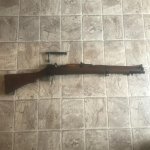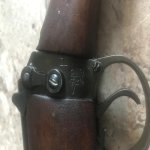Edit: Update on post #19
Hi CGN,
Seeking info on a unique Ishapore Lee Enfield .410 as I can’t seem to find much on the inter web.
Receiver is marked .410 RFI 1942 with a large P. The same large P is on top of the barrel just forward of the receiver.
Serial # 29### matches on the nose cap, bolt and receiver.
Wooden magazine plug is missing. (If it ever had it).
The chamber appears original but I can still see faint rifling down the bore.
The rear sight elevation is not pinned in place.
It’s in pretty remarkable condition for its age.
My questions are:
Is it possible this is a purpose built .410 as there is no conversion data on the right side of the receiver and numbers are matching?
What do the larges “P’s” signify?
I read the barrels have been bored out to .410. Would rifling still be visible?
Any significance on the unpinned rear sight?
Any idea of value?
Thanks in advance for any help!





Hi CGN,
Seeking info on a unique Ishapore Lee Enfield .410 as I can’t seem to find much on the inter web.
Receiver is marked .410 RFI 1942 with a large P. The same large P is on top of the barrel just forward of the receiver.
Serial # 29### matches on the nose cap, bolt and receiver.
Wooden magazine plug is missing. (If it ever had it).
The chamber appears original but I can still see faint rifling down the bore.
The rear sight elevation is not pinned in place.
It’s in pretty remarkable condition for its age.
My questions are:
Is it possible this is a purpose built .410 as there is no conversion data on the right side of the receiver and numbers are matching?
What do the larges “P’s” signify?
I read the barrels have been bored out to .410. Would rifling still be visible?
Any significance on the unpinned rear sight?
Any idea of value?
Thanks in advance for any help!





Attachments
-
 58934E5F-FB11-4C22-BD10-A65986D30304.jpg86.5 KB · Views: 319
58934E5F-FB11-4C22-BD10-A65986D30304.jpg86.5 KB · Views: 319 -
 BD7E8365-3299-4653-BF89-F370FA689ADC.jpg48.2 KB · Views: 317
BD7E8365-3299-4653-BF89-F370FA689ADC.jpg48.2 KB · Views: 317 -
 BC8D0A64-0C5B-409F-9C98-C420D15A4DD5.jpg26.1 KB · Views: 316
BC8D0A64-0C5B-409F-9C98-C420D15A4DD5.jpg26.1 KB · Views: 316 -
 2E315E2A-E2A8-4CC4-BDC3-36CDF5CEE677.jpg31.3 KB · Views: 314
2E315E2A-E2A8-4CC4-BDC3-36CDF5CEE677.jpg31.3 KB · Views: 314 -
 ED3B7B4E-9EA5-423E-B009-29D4259FB368.jpg49.7 KB · Views: 316
ED3B7B4E-9EA5-423E-B009-29D4259FB368.jpg49.7 KB · Views: 316
Last edited:






































































